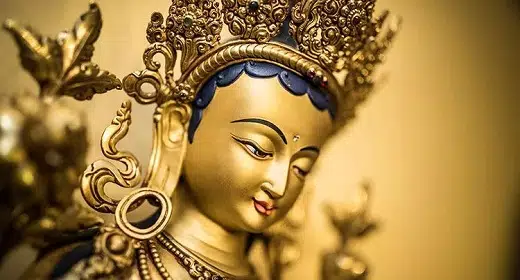The bodhisattva seated in meditation is among the most iconic Buddhist images…
If you’ve been learning about meditation, you may be wondering what does bodhisattva mean? In brief, a bodhisattva is anyone who has dedicated their own awakening to the benefit of all others. There are historic bodhisattvas we look to for inspiration, but anyone can be a bodhisattva, including you.
In Mahayana Buddhism, the bodhisattva is someone who has taken a vow to put others first. Ordinarily, we are self-centered beings. We tend to think of ourselves first, and we’re primarily concerned with our own happiness, gain and fame. As we take the first steps on our meditation journey, we bring along these me-first attitudes. Our meditation goals center on improving our own lives and becoming happier, wiser human beings.
But with daily meditation, we develop a greater sense of compassion and selflessness. We discover true happiness comes from ensuring the happiness of others, and that just like us, everyone only wants to be free from their pain. As we heal ourselves, we naturally become inclined to want to heal others.
Enter the bodhisattva ideal, one of the primary differences between Theravada and Mahayana Buddhism. In Mahayana Buddhism, the goal is not only to relieve our own pain and suffering, but to develop into a powerfully compassionate being who is capable of healing the pain of all beings everywhere.
Following the example of the historical Buddha, who gave up the comfort of his palace for the sake of all others, the bodhisattva says, let me be the one to do the work.
In this way, becoming a bodhisattva is about taking responsibility. We accept our role in creating our own suffering, and equally take responsibility for creating our own joy. This is also a practical matter. If we don’t take responsibility for our own minds, behavior, and contribution to a better world, who will do it for us?
Three ways of becoming a Bodhisattva
Bodhicitta is the state of mind that compels us to aspire to bodhisattva status. Bodhicitta means awakened mind or heart, and rediscovering this innate aspect of our being is a central aspect of Mahayana Buddhist practice. With bodhicitta in our hearts, we urgently strive to save all beings. But in our current condition, how can we? We can barely help ourselves, much less the entire world.
So do we wait to become enlightened before attempting to be helpful? Yes and no. In Mahayana Buddhism, the desire to help others, the wish to become enlightened for this purpose, and fruition of the path all go hand in hand. This process unfolds in the following three ways:
- The Way of the King: Just as a king crowns himself before helping his subjects, the ‘king’ bodhisattva seeks his own liberation first, which allows him to help others.
- The Way of the Captain: Just as the captain and passengers arrive at the far shore together, the ‘captain’ bodhisattva seeks simultaneous enlightenment with all sentient beings.
- The Way of the Shepherd: Just as a shepherd drives her sheep to shelter while following from behind, the ‘shepherd’ bodhisattva guides all others to enlightenment first.
We may embody any one of these modes at any point along our journey, sometimes all three in a single day!
Are there Bodhisattvas among us?
Avalokiteshvara, the embodiment of compassion, is perhaps the most well-known bodhisattva. Known as Chenrezig in Tibet, or Guanyin in China, this bodhisattva is often depicted with many arms, representing the ability to help many others simultaneously.
Among the beliefs of mahayana buddhism is that bodhisattvas walk among us today, inspiring us to dedicate our lives to the service of others. While Buddhist and other spiritual teachers may embody this ideal, anyone can be a bodhisattva, whether in a lifetime of service or moments of generosity. Celebrities who donate their fortune, heroic caregivers who put their own lives at risk, or our suspiciously selfless next door neighbor may all be bodhisattvas.
The point is, becoming a bodhisattva is something we can each aspire to. The next time you meditate, generate bodhicitta by setting an intention. Try “may my efforts here today be of benefit to others.” When you close your meditation, end with a dedication such as “may the benefits I’ve received benefit all beings everywhere.”
This simple mahayana buddhist practice reminds us that each step we take toward our own wellbeing is a step taken to benefit all.
Inspired? Learn the profound mahayana practices of lovingkindness and compassion in our online course series!
If you’ve read this far, you must be interested in the practice of meditation and its result: the experience of enduring joy and well-being. You’ve come to the right place.
Genuine meditation practices nurture our innate potential for happiness and awareness. Clear and progressive instructions are essential for successful practice. Mindworks created its 9-level Journey to Well-Being and other inspiring courses so you can enjoy the full potential of a regular meditation practice.





















































